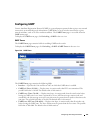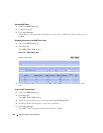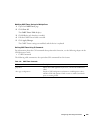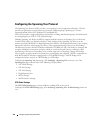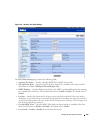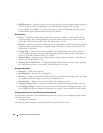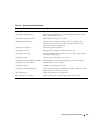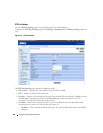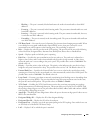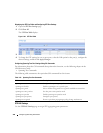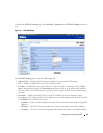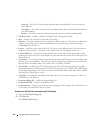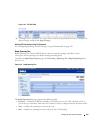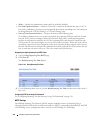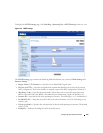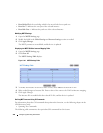
Configuring Switching Information 349
–
Blocking
— The port is currently blocked and cannot be used to forward traffic or learn MAC
addresses.
–
Listening
— The port is currently in the listening mode. The port cannot forward traffic nor can it
learn MAC addresses.
–
Learning
— The port is currently in the learning mode. The port cannot forward traffic, however,
it can learn new MAC addresses.
–
Forwarding
— The port is currently in the forwarding mode. The port can forward traffic and learn
new MAC addresses.
•
STP Root Guard
— Prevents the root of a Spanning Tree instance from changing unexpectedly. When
a root bridge has root guard enabled and a superior BPDU arrives, that port is moved to a root-
inconsistent state, which equates to the listening state. The root bridge is enforced.
•
Role
— Displays the role this port has in the STP topology. The port role will be one of the following
values: Root Port, Designated Port, Alternate Port, Backup Port, Master Port or Disabled Port.
•
Speed
— Displays speed at which the port is operating.
•
Path Cost
— Specifies the port contribution to the root path cost. The path cost is adjusted to a
higher or lower value, and is used to forward traffic when a path is being rerouted. A value of zero
means the path cost is set according to the port's speed. The possible values are 0 to 200000000. The
default value is 0.
•
Priority
— Specifies priority value of the port. The priority value influences the port choice when a
bridge has two ports connected in a loop. The possible values are 0 to 240. The default value is 128.
•
External Path Cost
— Specifies the External Path Cost to a new value for the specified port in the
spanning tree. Enter 0 to set the external path cost value automatically on the basis of Link Speed. The
possible values are 0 to 200000000. The default value is 0.
•
Loop Guard
— Prevents a port from erroneously transitioning from blocking state to forwarding when
the port stops receiving BPDUs. The port is marked as being in loop-inconsistent state. In this state,
the port does not forward packets. The possible values are
Enable
or
Disable
.
•
TCN Guard
— Enabling the TCN Guard feature restricts the port from propagating any topology
change information received through that port. This means that even if a port receives a BPDU with
the topology change flag set to true, the port will not flush its MAC address table and send out a BPDU
with a topology change flag set to true.
•
Auto Edge
— Enabling the Auto Edge feature allows the port to become an edge port if it does not see
BPDUs for some duration.
•
Designated Bridge ID
— Displays the ID of the designated bridge.
•
Designated Port ID
— Displays the ID of the selected port.
•
Designated Cost
— Displays cost of the port participating in the STP topology. Ports with a lower cost
are less likely to be blocked if STP detects loops.
•
LAG
— Displays LAG to which the port is attached.



